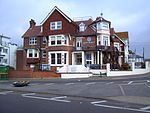Our Lady Help of Christians and St Helen's Church, Westcliff-on-Sea
1862 establishments in England20th-century Roman Catholic church buildings in the United KingdomChurches in Southend-on-Sea (town)Gothic Revival architecture in EssexGothic Revival church buildings in England ... and 4 more
Grade II listed Roman Catholic churches in EnglandGrade II listed churches in EssexRoman Catholic churches completed in 1903Roman Catholic churches in Essex

St Helen's Church (formally Our Lady Help of Christians and St Helen's Church) is a Roman Catholic Parish church in Westcliff-on-Sea in Southend-on-Sea, Essex, England. It was founded in 1862 and built in 1867. Further extensions were made to the church from 1898 to 1903, designed by Alexander Scoles. It is situated on Milton Road near to the corner of St Helen's Road, next to St Bernard's High School. It is a Gothic Revival church, the first post-Reformation Catholic church to be built in Southend and a Grade II listed building.
Excerpt from the Wikipedia article Our Lady Help of Christians and St Helen's Church, Westcliff-on-Sea (License: CC BY-SA 3.0, Authors, Images).Our Lady Help of Christians and St Helen's Church, Westcliff-on-Sea
St Helen's Road, Southend-on-Sea Prittlewell
Geographical coordinates (GPS) Address External links Nearby Places Show on map
Geographical coordinates (GPS)
| Latitude | Longitude |
|---|---|
| N 51.538097 ° | E 0.699845 ° |
Address
Our Lady Help of Christians & St Helen's Catholic Church
St Helen's Road
SS0 7JP Southend-on-Sea, Prittlewell
England, United Kingdom
Open on Google Maps








